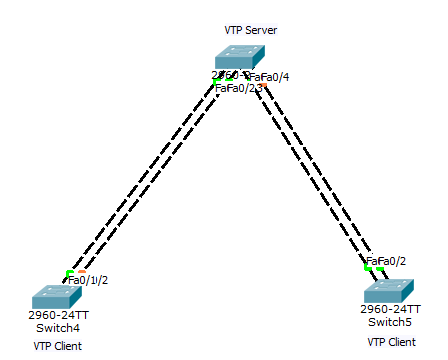- مدیر
- تیر 17, 1393
- 3:34 ب.ظ
- بدون نظر
خلاصه این مطلب :
موضوع:VLAN Trunking Protocol (VTP)
شاید بهترین تعریف برای VTPعبارت زیر باشه :
VLAN Trunking Protocol, also known as VTP is a technology that allows for the propagation of VLAN’s from a single switch to multiple switches in a Server-Client fashion.
تکنولوژی که به وسیله آن میتوانیم بر روی یک سویچ Vlanها را تعریف کرد و به صورت اتو ماتیک Vlanها را بر روی تمامی سویچهای موجود در شبکه انتشار داد.
به این صورت که یک سویچ را به عنوان سرور در نظر می گیریم ،سپس Vlanهای مورد نظر را تعریف کرده و سایر سویچهای موجود در شبکه را Client در نظر گرفته. در این حالت ما می توانیم هر تغییری را مانند حذف اضافه و … را بر روی یک سویچ انجام داد و بعد بر روی تمامی سویچهای موجود در شبکه منتشر شود.
In the world of VTP, the VTP Server is the centralized point of management in the network for VLAN propagation. Whenever you create a new VLAN on the VTP Server, this VLAN will automatically be propagated to the switches in the same VTP Domain. Think of a VTP Domain as a single autonomous system, or a single collection of switches that share the same VLAN’s. For example you have a large campus building in a University network. This building in the three tier design model will have an access and distribution core. The VTP Server in this design would be the distribution switch. In most cases, the VTP server would be a chassis switch or a switch stack to provide redundancy to access switches.
Creating a VLAN on the distribution switch will allow for all access switches to access other access switches on different floors of the building on the same VLAN, this eliminates the need to create the Vlan on 3 separate switches, the distribution, and both access switches in the given example.
In large enterprise networks VTPv2 can be used in the campus core as VTPv2 can only propagate up to 1005 VLAN’s, however once you hit the VTP VLAN ceiling you’d be required to migrate to VTP Version 3 to allow for the propagation of 4095 VLAN’s.
There are three VTP Versions currently; VTP Version 3 which is quite new provides major advantages over versions one and two.
VTP Version 1 was the initial release of this technology gives you the ability to configure the switch as a VTP Server, VTP Client, VTP Transparent Switch (will be discussed in Lab 4-11) and on CatOS switches, VTP Mode OFF which completely disables VTP.
VTP Version 2 is not to much different from v1 however VTPv2 includes the support for token ring VLAN’s and VTP Pruning. If neither of these features are required in a network then there is no need to upgrade from version one to version two.
VTP Version 3 on the other hand has significant advantages over its predecessors, two of the most beneficial features to modern networks is that VTP v3 supports the entire IEEE VLAN Range 1-4095 and also the ability to propagate Private VLAN information. VTP v3 also gives better administrative control over the VTP domain by allowing you to configure which devices can update other devices view of the VLAN topology. You now have the option to turn VTP on or off on a per trunk basis and now the VTP server has a primary and backup VTP server.
Now take a step back for a second and ask yourself what happens if someone else plugs a switch into the network with the same VTP domain and a higher revision of the database and completely different VLAN information. The answer is quite simple, you’re network goes into the bit bucket as your VLAN’s on all switches change, some get removed, new ones added and so on. When a VLAN is removed on a switch and ports are in that specific VLAN, those ports get shutdown. All in all, if this happens on your watch and its your fault you better update your resume.
But don’t worry, there is hope!! With the a VTP Password, you can prevent unwanted VTP server switches in the network. By using a VTP password switches can only be a client of a VTP Server if the passwords match.
VTP Domains can be unique to location but there is one domain name that is special; VTP Domain: NULL, this domain name basically is no domain name, its blank and is represented as the domain name NULL. However when it is changed you cannot change it back to NULL.
سناریوی زیر رو در نظر بگیرید:
کانفیگ های زیر رو در SW1انجام بدید:
Sw1#conf t
Enter configuration commands, one per line. End with CNTL/Z.
Sw1(config)#vtp mode server
Device mode already VTP SERVER.
Sw1(config)#vtp domain test.loc
Changing VTP domain name from NULL to test.loc
کانفیگ مربوت به SW2:
Sw2#conf t
Enter configuration commands, one per line. End with CNTL/Z.
Sw2(config)#vtp mode client
Setting device to VTP CLIENT mode.
Sw2(config)#vtp domain test.loc
Changing VTP domain name from NULL to test.loc
کانفیگ مربوت به SW3:
Sw3#conf t
Enter configuration commands, one per line. End with CNTL/Z.
Sw3(config)#vtp mode client
Setting device to VTP CLIENT mode.
Sw3(config)#vtp domain test.loc
Changing VTP domain name from NULL to test.loc
اینتر فیسهای fa0/1-2را در channel-group1 و اینتر فیسهای fa0/3-4را در channel-group2 قرار می
دهیم. در SW1
SW1(config)#int range fastEthernet 0/1-2
SW1(config-if-range)#channel-group 1 mode on
SW1(config)#int range fastEthernet 0/3-4
SW1(config-if-range)#channel-group 2 mode on
اینتر فیسهای fa0/1-2را در channel-group 1قرار می دهیم در SW2
SW2(config)#int range fastEthernet 0/1-2
SW2(config-if-range)#channel-group 1 mode on
اینتر فیسهای fa0/1-2را در channel-group 1قرار می دهیم در SW3
SW3(config)#interface range fastEthernet 0/1-2
SW3(config-if-range)#channel-group 2 mode on
با استفاده از شماره channel-groupها انها را ترانک می کنیم در SW1
SW1(config)#interface port-channel 1
SW1(config-if)#switchport mo trunk
SW1(config)#interface port-channel 2
SW1(config-if)#switchport mode trunk
Channel-group 1را ترانک می کنیم .در SW2
SW2(config)#interface port-channel 1
SW2(config-if)#switchport mode trunk
Channel-group 2را ترانک می کنیم .در SW3
SW3(config)#interface port-channel 2
SW3(config-if)#switchport mode trunk
Vlan 10 را با نام 20learn.ir ایجاد می کنیم.
Sw1(config)#vlan 10
Sw1(config-vlan)#name 20learn.ir
نمایش تمامی vlan ها :در SW1
SW1#show vlan brief
VLAN Name Status Ports
—- ——————————– ——— ——————————-
1 default active Fa0/5, Fa0/6, Fa0/7, Fa0/8
Fa0/9, Fa0/10, Fa0/11, Fa0/12
Fa0/13, Fa0/14, Fa0/15, Fa0/16
Fa0/17, Fa0/18, Fa0/19, Fa0/20
Fa0/21, Fa0/22, Fa0/23, Fa0/24
Gig1/1, Gig1/2
10 20learn.ir active
1002 fddi-default active
1003 token-ring-default active
1004 fddinet-default active
1005 trnet-default active
نمایش تمامی vlan ها :در SW2
SW2#show vlan brief
VLAN Name Status Ports
—- ——————————– ——— ——————————-
1 default active Fa0/3, Fa0/4, Fa0/5, Fa0/6
Fa0/7, Fa0/8, Fa0/9, Fa0/10
Fa0/11, Fa0/12, Fa0/13, Fa0/14
Fa0/15, Fa0/16, Fa0/17, Fa0/18
Fa0/19, Fa0/20, Fa0/21, Fa0/22
Fa0/23, Fa0/24, Gig1/1, Gig1/2
10 20learn.ir active
1002 fddi-default active
1003 token-ring-default active
1004 fddinet-default active
1005 trnet-default active
VTP Password and VTP version
خب اگر کسی بیاد در شبکه ما یک سویچ بزاره با همون نام دامنه ما (در اینجا Test.loc) با تنضیمات متفاوت و Revision
Numberبا لاتر برخی از vlan ها حذف می شوند بعضی اضافه می شوند و ….
با استفاده از VTP Password شبکه از این گونه حملات در امان می ماند .به این صورت که کلاینت هایی تغییرات جدید را
دریافت می کنند که پسورد آنها با پسورد VTP Server Matchباشد.
کانفیگ VTP Password و VTP versionدر سویچهای کلاینت و سرور.
در SW1:
SW1#configure terminal
Enter configuration commands, one per line. End with CNTL/Z.
SW1(config)#vtp version 2
SW1(config)#vtp password Cisco
در SW2:
SW2#configure terminal
Enter configuration commands, one per line. End with CNTL/Z.
SW2(config)#vtp password Cisco
Setting device VLAN database password to Cisco$123
در SW3:
SW3#configure terminal
Enter configuration commands, one per line. End with CNTL/Z.
SW3(config)#vtp password Cisco
Setting device VLAN database password to Cisco$123
با دستور Show Vtp Password میتونیم پسورد رو ببینیم.
SW1#show vtp password
VTP Password: cisco








